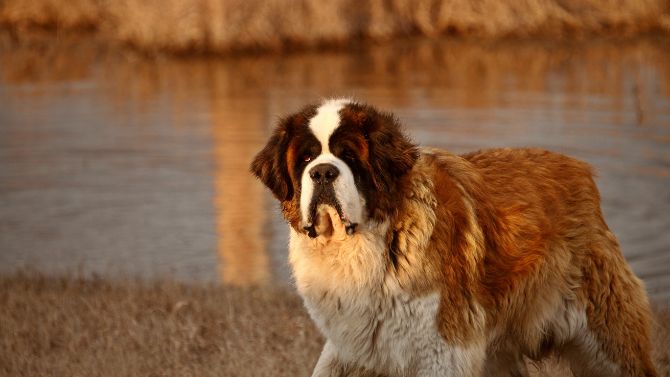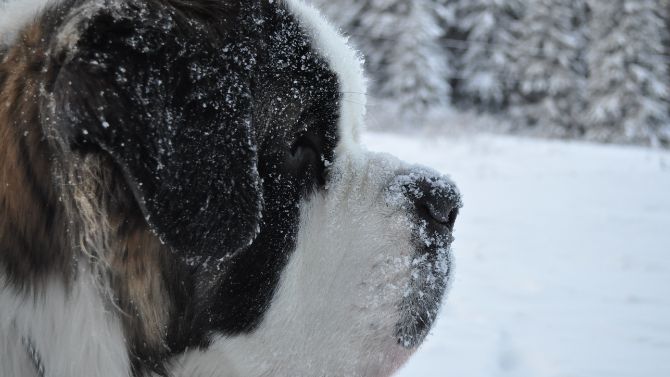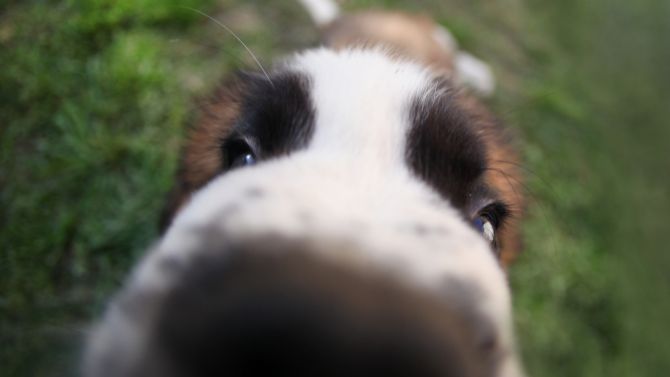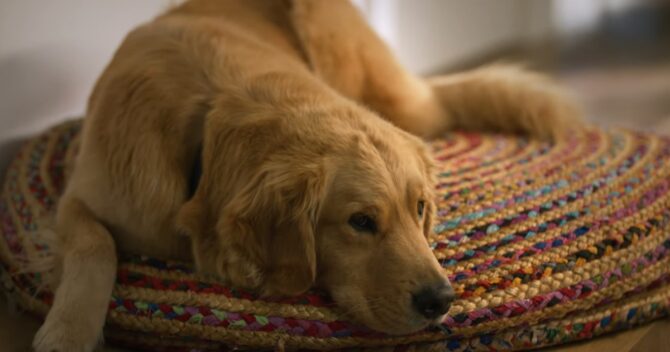When discussing famous movie dogs, Cujo is almost certain to come up in the conversation. This large and fearsome canine, who terrorizes a mother and her child after being bitten by a bat, is one of cinema’s most iconic villains.
But what breed of dog was Cujo, and what can we learn from his depiction in the movies? Today, we will discuss the history, breed specifics, and cinematic portrayal of this unforgettable character.
The Origins
Cujo is a creation from the mind of none other than Stephen King, the master of horror. King has stated that the inspiration for the story came from a real-life encounter with a ferocious dog. One day, King had visited a mechanic’s remote farmhouse to have his motorcycle repaired.
While there, he confronted a snarling Saint Bernard. Although the dog didn’t harm King, the menacing encounter stayed with him.
- St. Bernard Behavior: The real-life dog that inspired King was, in fact, a Saint Bernard. But contrary to their portrayal in the Cujo novel and film, Saint Bernards are typically gentle and good-natured dogs.
- Real-Life vs. Fiction: King took creative liberties in magnifying the dog’s aggression for dramatic effect, building upon people’s innate fears of large, uncontrollable animals.
From Book to Screen

Translating the menace and terror of Cujo from the pages of King’s book to the silver screen posed certain challenges for filmmakers. To bring the character to life, several Saint Bernards, a mechanical head, and even a man in a dog suit were used for different scenes.
- Multiple Dogs: Training dogs for movie roles, especially intense ones like Cujo, often requires using multiple animals to capture various emotions or actions.
- Safety First: To ensure the safety of the actors, as well as the welfare of the dogs, many scenes were carefully choreographed. Despite the terrifying on-screen presence, the dogs were well-cared-for and were often wagging their tails between takes!
Saint Bernards: A Brief History of the Breed
The Saint Bernard breed originates from the Swiss Alps, where they were primarily used as rescue dogs by the monks of the Great St. Bernard Hospice. Their primary role was to help find and save travelers who were lost or buried by avalanches.
Physical Features
Saint Bernards are large, powerful dogs with a keen sense of smell and direction. Their sturdy build and dense fur make them well-suited for harsh alpine conditions.
A Rescue Legacy
The legacy of Saint Bernards, especially their role as life-saving heroes in the Swiss Alps, deserves to be celebrated as much as any fictional portrayal. Their impressive rescue legacy speaks volumes about their potential as gentle, loyal companions. For those interested in harnessing the natural instincts and loyalty of their dogs, finding the right training facility is essential. Tailored training programs, like those offered on this website, provide a compassionate and structured approach that brings out the best in dogs of all breeds, fostering relationships built on respect and understanding.
Temperament and Behavior
Contrary to the menacing portrayal of Cujo, Saint Bernards are known for their gentle and friendly nature. They are affectionate and are particularly good with children, often being described as “gentle giants,” and are one of the cutest dog breeds in the world.
- Social Creatures: Saint Bernards thrives on human interaction and can suffer from separation anxiety if left alone for extended periods.
- Training is Key: Like any dog breed, proper training and socialization from a young age are crucial. A well-trained Saint Bernard is calm gentle, and can be a delightful addition to any family.
Cujo’s Impact on Popular Culture

Cujo’s cinematic debut in 1983 left an indelible mark on horror movie enthusiasts. The film’s intense portrayal of a once-beloved family pet turned deadly predator played into viewers’ primal fears, making it a classic in its genre.
- Reception: While the film received mixed reviews, it was praised for its tension-filled sequences and performances, especially Dee Wallace’s role as the besieged mother.
- Cultural Impact: Cujo’s name has since become synonymous with menacing dogs, often referenced in other movies, TV shows, and pop culture.
The Saint Bernard Post-Cujo
While the Cujo film amplified Saint Bernard’s popularity, it unfortunately also perpetuated some myths about the breed’s temperament. Many viewers unfamiliar with the breed might mistakenly associate Saint Bernards with aggression because of Cujo.
- Clarifying Misconceptions: Dog enthusiasts and breeders often find themselves dispelling myths about Saint Bernard’s temperament post-Cujo.
- Awareness and Education: The key to breaking these misconceptions is raising awareness about the true nature of the breed and emphasizing the importance of proper training and socialization for all dogs.
The Legacy and Lessons of Cujo

Beyond the surface-level terror, Cujo offers profound insights into human nature and society. King, a master storyteller, often uses horror as a lens to magnify human fears, insecurities, and flaws.
- Facing Our Fears: The trapped mother and son in Cujo symbolize our universal fears of confinement, helplessness, and unseen threats.
- The Man vs. Nature Dichotomy: The story also explores the age-old conflict between man and nature. Cujo, initially a gentle dog, turns violent due to circumstances (a rabid bat bite), posing the question: Can we ever truly tame nature, or are we always at its mercy?
The Humanization of Animals in Cinema
Animals in films often serve as mirrors of human emotions, characteristics, and dilemmas. Cujo, for instance, is more than just a rabid dog; he represents the unpredictable and wild side of nature that can suddenly turn against us.
- Empathy vs. Fear: While Cujo elicits fear as the antagonist, there are moments in the film where viewers can’t help but feel pity for the suffering animal. This duality prompts us to reflect on our relationships with animals and the responsibilities that come with pet ownership.
- Bigger Picture: It’s crucial to recognize the fictional nature of such portrayals and not generalize them to entire breeds or species. As with Cujo and the Saint Bernard, cinema’s representation doesn’t always match reality.
Preserving the Integrity of Breeds
Movies and literature wield a significant influence over society’s perceptions. The portrayal of specific dog breeds in aggressive or negative roles can inadvertently perpetuate misconceptions and biases.
- Awareness and Responsibility: Filmmakers and writers must recognize their role in shaping perceptions and strive for balanced portrayals.
- Distinguishing Fiction from Reality: Viewers, too, bear the responsibility of discerning between fiction and reality, ensuring that they don’t let fictional portrayals cloud their judgment about entire breeds.
Promoting Positive Breed Representation

Championing positive breed representation is essential to counteract the effects of movies like Cujo. While the film serves as a gripping horror story, it’s crucial to separate the cinematic portrayal from real-life breed characteristics.
- Showcasing Success Stories: Media can focus on real-life stories where breeds, often misunderstood, play heroic or loving roles.
- Education and Outreach: Breed enthusiasts and organizations can host events, workshops, and programs highlighting the positive attributes of breeds, dispelling myths, and fostering understanding.
FAQs
What other works has Stephen King written involving animals?
Stephen King has explored the theme of animals in several of his works. Some notable mentions include “Pet Sematary,” where a family’s cat is resurrected with malevolent tendencies, and “The Stand,” where a dog named Kojak becomes an essential character. King often uses animals to delve deeper into human emotions, fears, and relationships.
Are there other films where Saint Bernard is depicted in a more positive light?
Yes, there are. A famous example is the “Beethoven” movie series, which portrays a mischievous but lovable Saint Bernard who gets into various comedic situations, offering a stark contrast to Cujo’s portrayal.
How does the rabies virus, which Cujo contracts in the story, affect dogs in real life?
Rabies is a fatal virus that affects the central nervous system. In dogs, symptoms can include fever, seizures, paralysis, hydrophobia, and increased aggression.
It’s essential for dog owners to vaccinate their pets against rabies to prevent infection and transmission.
Did Stephen King ever express regret or clarify his intentions regarding the negative portrayal of Saint Bernards in “Cujo”?
Stephen King has often discussed the themes and inspirations behind his works, emphasizing their fictional nature. While “Cujo” presents a terrifying depiction of a Saint Bernard, King’s aim was not to demonize the breed but rather to explore the horror of a beloved pet turning against its owners due to unforeseen circumstances.
What should potential Saint Bernard owners consider before adopting or purchasing one?
Prospective Saint Bernard owners should be prepared for a large, active dog that requires regular exercise, grooming, and training.
It’s also essential to understand the breed’s health needs, potential for drooling, and their typically affectionate and gentle temperament.
How has the Saint Bernard breed evolved over the years since the movie’s release?
The Saint Bernard breed has remained consistent in its core characteristics since the movie’s release. However, responsible breeding practices have focused on maintaining the breed’s health and temperament.
Awareness campaigns post-Cujo have also worked towards ensuring that the breed isn’t unjustly stigmatized due to the movie’s portrayal.
Final Words
While Cujo may have painted a horrifying picture of the Saint Bernard, it’s essential to distinguish fiction from reality. This majestic breed, known for its gentle nature and heroic rescue legacy, deserves recognition beyond the confines of horror cinema.
So, the next time you come across a Saint Bernard, remember the real-life heroes of the Swiss Alps rather than the fictional menace of Cujo.






